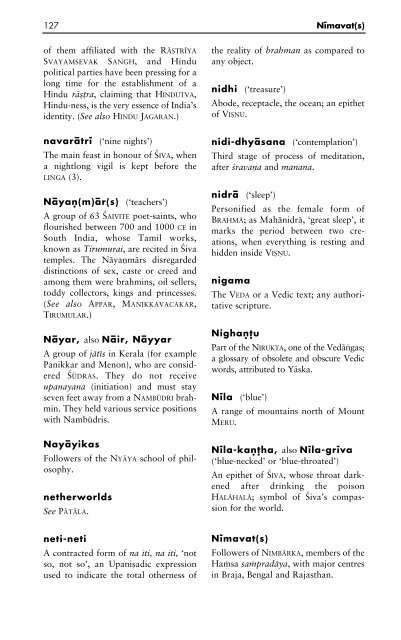A Concise Encyclopedia of Hinduism Klaus K Klostermaie
You also want an ePaper? Increase the reach of your titles
YUMPU automatically turns print PDFs into web optimized ePapers that Google loves.
127 Nïmavat(s)<br />
<strong>of</strong> them affiliated with the RÄÆfiRÏYA<br />
SVAYAMSEVAK SANGH, and Hindu<br />
political parties have been pressing for a<br />
long time for the establishment <strong>of</strong> a<br />
Hindu rä•flra, claiming that HINDUTVA,<br />
Hindu-ness, is the very essence <strong>of</strong> India’s<br />
identity. (See also HINDU JAGARAN.)<br />
navarätrï (‘nine nights’)<br />
The main feast in honour <strong>of</strong> ŸIVA, when<br />
a nightlong vigil is kept before the<br />
LI¢GA (3).<br />
Näyaæ(m)är(s) (‘teachers’)<br />
A group <strong>of</strong> 63 ŸAIVITE poet-saints, who<br />
flourished between 700 and 1000 CE in<br />
South India, whose Tamil works,<br />
known as Tirumurai, are recited in Ÿiva<br />
temples. The Näyaæmärs disregarded<br />
distinctions <strong>of</strong> sex, caste or creed and<br />
among them were brahmins, oil sellers,<br />
toddy collectors, kings and princesses.<br />
(See also APPAR, MANIKKAVACAKAR,<br />
TIRUMULAR.)<br />
Näyar, also Näir, Näyyar<br />
A group <strong>of</strong> jätïs in Kerala (for example<br />
Panikkar and Menon), who are considered<br />
ŸÜDRAS. They do not receive<br />
upanayana (initiation) and must stay<br />
seven feet away from a NAMBÜDRI brahmin.<br />
They held various service positions<br />
with Nambüdris.<br />
Nayäyikas<br />
Followers <strong>of</strong> the NYÄYA school <strong>of</strong> philosophy.<br />
netherworlds<br />
See PÄTÄLA.<br />
the reality <strong>of</strong> brahman as compared to<br />
any object.<br />
nidhi<br />
(‘treasure’)<br />
Abode, receptacle, the ocean; an epithet<br />
<strong>of</strong> VIÆŒU.<br />
nidi-dhyäsana (‘contemplation’)<br />
Third stage <strong>of</strong> process <strong>of</strong> meditation,<br />
after ÿravaæa and manana.<br />
nidrä (‘sleep’)<br />
Personified as the female form <strong>of</strong><br />
BRAHMÄ; as Mahänidrä, ‘great sleep’, it<br />
marks the period between two creations,<br />
when everything is resting and<br />
hidden inside VIÆŒU.<br />
nigama<br />
The VEDA or a Vedic text; any authoritative<br />
scripture.<br />
Nighaæflu<br />
Part <strong>of</strong> the NIRUKTA, one <strong>of</strong> the Vedäögas;<br />
a glossary <strong>of</strong> obsolete and obscure Vedic<br />
words, attributed to Yäska.<br />
Nïla<br />
(‘blue’)<br />
A range <strong>of</strong> mountains north <strong>of</strong> Mount<br />
MERU.<br />
Nïla-kaæflha, also Nïla-grïva<br />
(‘blue-necked’ or ‘blue-throated’)<br />
An epithet <strong>of</strong> ŸIVA, whose throat darkened<br />
after drinking the poison<br />
HALÄHALÄ; symbol <strong>of</strong> Ÿiva’s compassion<br />
for the world.<br />
neti-neti<br />
A contracted form <strong>of</strong> na iti, na iti, ‘not<br />
so, not so’, an Upani•adic expression<br />
used to indicate the total otherness <strong>of</strong><br />
Nïmavat(s)<br />
Followers <strong>of</strong> NIMBÄRKA, members <strong>of</strong> the<br />
Haƒsa saƒpradäya, with major centres<br />
in Braja, Bengal and Rajasthan.


















